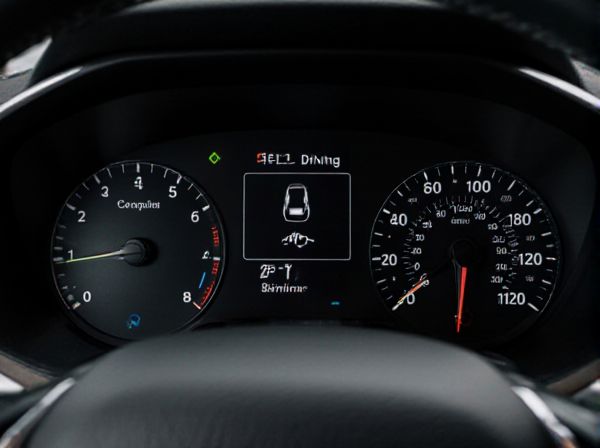
Photo illustration: Eco Driving Indicator vs Performance Meter
An Eco Driving Indicator helps you monitor and improve fuel efficiency by providing real-time feedback on your driving habits, promoting environmentally friendly and cost-effective behavior. In contrast, a Performance Meter focuses on vehicle dynamics such as acceleration, power output, and engine performance for enthusiasts seeking to optimize driving performance. Understanding the differences between these tools allows you to choose the right system based on whether your priority is economy or performance.
Table of Comparison
| Feature | Eco Driving Indicator | Performance Meter |
|---|---|---|
| Primary Purpose | Optimize fuel efficiency and reduce emissions | Monitor and enhance engine performance |
| Data Metrics | Fuel consumption, throttle input, driving behavior | RPM, torque, acceleration, power output |
| User Feedback | Visual cues for eco-friendly driving | Real-time performance stats and alerts |
| Driving Focus | Promotes smooth acceleration and steady speed | Encourages dynamic, high-performance driving |
| Environmental Impact | Reduces carbon footprint and fuel costs | No direct environmental benefits |
| Target Users | Eco-conscious drivers, city commuters | Performance enthusiasts, sports car drivers |
Introduction to Eco Driving Indicators and Performance Meters
Eco Driving Indicators provide real-time feedback on driving habits to promote fuel efficiency and reduce emissions by monitoring parameters like acceleration, speed, and braking patterns. Performance Meters focus on overall vehicle performance metrics, including engine power output, fuel consumption, and driving dynamics, offering insights for optimized driving and vehicle maintenance. Both tools use sensor data and onboard diagnostics to enhance driving behavior and vehicle efficiency, contributing to sustainable and cost-effective transportation.
How Eco Driving Indicators Work
Eco Driving Indicators use real-time data from the vehicle's engine control unit (ECU) to monitor parameters such as fuel consumption, throttle position, and speed, providing immediate feedback to promote fuel-efficient driving habits. These systems typically display color-coded signals or numerical scores on the dashboard to encourage smoother acceleration and deceleration, reducing unnecessary fuel usage. In contrast, Performance Meters focus on measuring metrics like horsepower and torque output, prioritizing driving performance rather than fuel efficiency.
Understanding Performance Meters
Performance meters provide real-time feedback on driving behavior by monitoring metrics like acceleration, braking, and engine RPM to optimize vehicle efficiency and safety. Unlike Eco Driving Indicators that primarily focus on fuel economy, performance meters offer a comprehensive analysis of driving habits to improve overall vehicle performance and reduce wear and tear. Understanding performance meters helps drivers make informed adjustments, enhancing both driving efficiency and longevity of vehicle components.
Key Differences Between Eco Driving Indicators and Performance Meters
Eco Driving Indicators primarily measure fuel efficiency and promote environmentally friendly driving habits by providing real-time feedback on acceleration, braking, and gear shifts. In contrast, Performance Meters focus on vehicle dynamics such as speed, acceleration, and engine power to optimize driving performance and responsiveness. The key difference lies in their objectives: Eco Driving Indicators aim to reduce fuel consumption and emissions, while Performance Meters enhance driving performance and vehicle control.
Benefits of Eco Driving Indicators for Fuel Efficiency
Eco Driving Indicators enhance fuel efficiency by providing real-time feedback on driving habits, encouraging smoother acceleration and optimal gear shifts that reduce fuel consumption. Unlike Performance Meters, which focus on maximizing power and speed, Eco Driving Indicators prioritize economical driving patterns that lower emissions and extend vehicle lifespan. This targeted feedback supports drivers in maintaining steady speeds and minimizing idling time, resulting in significant fuel savings and cost reductions over time.
Performance Meters: Focus on Speed and Acceleration
Performance meters primarily measure speed and acceleration to provide real-time feedback on driving behavior, enhancing vehicle performance and safety. These devices track rapid changes in velocity and acceleration rates, assisting drivers in maintaining optimal control and reducing wear on mechanical components. By focusing on these key metrics, performance meters help improve fuel efficiency and driving dynamics more effectively than standard eco driving indicators.
Impact on Vehicle Emissions and Environmental Sustainability
Eco Driving Indicators directly influence vehicle emissions by promoting fuel-efficient driving behaviors, which reduce carbon dioxide and nitrogen oxide outputs, contributing to improved air quality and environmental sustainability. Performance Meters emphasize power and acceleration metrics, potentially encouraging aggressive driving styles that increase fuel consumption and harmful emissions. Prioritizing Eco Driving Indicators supports sustainable transportation by minimizing the ecological footprint of individual vehicles and aligning with global emission reduction targets.
Choosing the Right System for Your Driving Needs
Eco Driving Indicators prioritize fuel efficiency by providing real-time feedback on smooth acceleration, steady speed, and reduced idling, making them ideal for drivers focused on minimizing fuel consumption and environmental impact. Performance Meters emphasize vehicle dynamics such as horsepower, torque, and acceleration metrics, catering to enthusiasts seeking to optimize driving performance and engine output. Selecting the right system depends on your primary goals: fuel economy and eco-friendliness favor the Eco Driving Indicator, while maximizing power and driving experience align better with the Performance Meter.
Integration of Indicators and Meters in Modern Vehicles
Integration of eco driving indicators and performance meters in modern vehicles enhances driver awareness by providing real-time feedback on fuel efficiency and engine performance. These systems utilize sensors and onboard computers to display data such as acceleration patterns, fuel consumption, and engine load on a unified dashboard interface. Combining eco driving indicators with performance meters supports optimized driving behavior, leading to reduced emissions and improved vehicle longevity.
Future Trends in Automotive Driving Assistance Systems
Eco Driving Indicator systems utilize real-time data and vehicle telematics to promote fuel-efficient driving, reducing emissions and optimizing energy consumption. Performance Meters analyze driving behavior and vehicle dynamics to enhance responsiveness and safety, integrating with AI-driven adaptive control systems. Future trends in automotive driving assistance will converge these technologies using machine learning algorithms to provide predictive feedback that balances eco-efficiency with dynamic performance for smarter, sustainable driving experiences.
 caratoz.com
caratoz.com